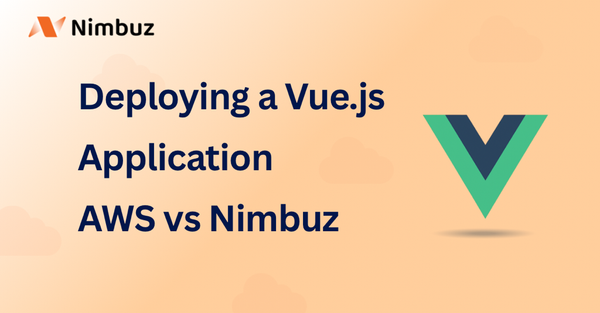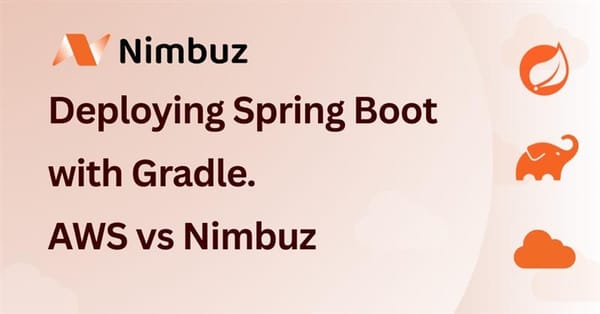Deploying GO on AWS vs Nimbuz
Building a Go (Golang) application offers unmatched performance and simplicity with its compiled binaries and built-in web server capabilities. But after writing efficient code, the real question arises — where to deploy it?
On one hand, AWS EC2 provides complete infrastructure control — from setting up servers, configuring firewalls, and managing SSL to scaling via load balancers. While powerful, it demands time and DevOps expertise.
On the other hand, Nimbuz abstracts away infrastructure complexities. With a few clicks or a simple upload, you get auto-provisioned environments, SSL, monitoring, and instant scalability.
Both can serve production-ready Go apps, but the deployment experience and operational overhead differ greatly.
Let’s explore how deployments work on both platforms and why Nimbuz is becoming the preferred choice for modern Go developers.
🔧 Key Technical Aspects of Deployment Components
- Go (Golang): Compiled language that produces standalone binaries, ideal for scalable backend services.
- Net/HTTP: Standard Go package for building REST APIs or web servers without extra dependencies.
Deploying a Go Application on AWS (EC2 Instance)
AWS EC2 provides deep configurability but requires significant manual setup.
A typical Go application deployment looks like this:
🧩 Prerequisites
- A working Go application (main.go).
- An AWS account with permissions to create EC2 instances, security groups, and optionally Route 53.
Step 1: Launch an EC2 Instance
- Log in to the AWS Management Console.
- Launch a new EC2 instance (Ubuntu or Amazon Linux).
- Configure Security Groups to allow ports 22 (SSH), 80 (HTTP), and 443 (HTTPS).
- Launch and note the Public IPv4 Address.
SSH into the instance:
ssh -i <path-to-ssh-key> ubuntu@<ec2-public-ip>

Step 2: Install Go
sudo apt update
sudo apt install golang-go -y

Verify installation:
go version

Step 3: Copy Application Files
Transfer your Go project to the instance:
scp -i <path-to-ssh-key> -r <application_path> ubuntu@<ec2-public-ip>:/home/ubuntu/
Step 4: Build and Run the Go Application
SSH again into the instance:
ssh -i <path-to-ssh-key> ubuntu@<ec2-public-ip>
cd /home/ubuntu/<app-folder>
go build -o app main.go
Run the binary:
./app
Your Go application should now be accessible at:
http://<ec2-public-ip>:8080

Deploying a Go Application on Nimbuz
Nimbuz streamlines Go deployments — no manual servers or SSH required. You simply upload your app, and it handles everything from SSL to scaling.
Typical Workflow:
- Sign up / Log in to Nimbuz.
- Create a Project and Environment (e.g., Development, Staging, Production).
- Upload as ZIP or Connect GitHub/GitLab – Compress your Go project folder (including the
main.goor compiled binary).

- Configure Environment Variables & Secrets – Inject configuration values securely from the dashboard.
- Deploy and Test – Once deployed, Nimbuz automatically provisions resources and generates a live preview URL.
- Monitor Logs & Performance – Check logs, uptime, and app health directly in the Nimbuz dashboard.
- Enable Public Access – Assign a domain and get auto-SSL (no Certbot, no renewals).
Your Go backend or API is now live — complete with HTTPS, monitoring, and scalability. 🚀
⚖️ Why AWS Feels Heavy for Go Deployments vs Nimbuz’s Effortless Workflow
| Category | AWS EC2 | Nimbuz |
|---|---|---|
| Setup & Deployment | Manual setup: install Go, configure ports, run app, manage services. | One-click upload or Git-based deployment. |
| Domain & SSL | Requires manual Certbot installation and renewals. | Auto SSL + custom domain with one click. |
| Scaling | Needs Load Balancer and Auto Scaling Groups. | Auto-scaling built-in — no config needed. |
| Monitoring | Use CloudWatch + manual log aggregation. | Built-in live logs and resource monitoring. |
| Cost & Billing | Multiple AWS components = unpredictable pricing. | Simple, transparent pricing with free tier. |
| Developer Experience | More DevOps than development. | Focus on code, not servers. |
Try Nimbuz Today!
Experience seamless app deployment with Nimbuz. No more manual setup - just focus on building.





